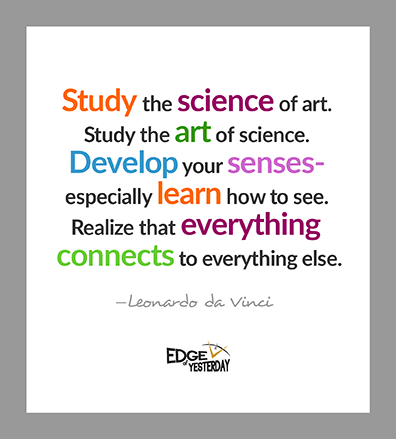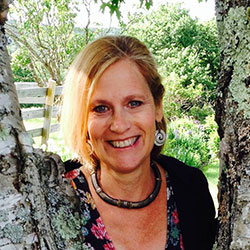Industry and the nature of work are transforming at lightspeed. What are the implications for GenZ? And does Leonardo da Vinci hold the key?
By Robin Stevens Payes
It can be hard finding the right way to find engaging way to help students acquire skills that make them future-proof, and make the learning relevant.
Perhaps STEM learning alone feels too disconnected from life. But where in the world could STEM, history, arts and story intersect?
Through time travel at the Edge of Yesterday.
“There are so few people to do the [apple] picking. So few people to do anything. And those of us who are left walk around as if we’re half asleep. We are all so tired.”
~ Year of Wonders, by Geraldine Brooks
It feels like a familiar story—a world wracked by pandemic, reeling from political upheaval, a crumbling economy. This passage could mark 2020, and not a remote annus mirabilis, 1666, described in the opening chapter of the historical novel, Year of Wonders.
But stories can draw you in, making the remote—perhaps uncomfortably—present. And the past echoes with lessons which, when applied to today, help us innovate forward.
I write science fiction for teens. As I was researching Saving Time, part of the Edge of Yesterday book series (EOY) —wherein a STEM-smart girl builds Leonardo da Vinci’s plans for a time machine that Leonardo designed—I noticed striking parallels between da Vinci’s times and our own: pandemics (think Black Death), climate change (the fifteenth-century experienced a mini-Ice Age), massive social upheaval (Inquisition, anyone?), and a blossoming of new technologies (printing press, linear perspective, double-shelled dome), innovations in art and science, and a populist form of republican governance in Florence.
It struck me that the true genius of the master may not have been so much his unparalleled artistic talents or engineering prowess, as his curiosity, and a unique ability to find connections between the many fields that captured his attention. Leonardo said, “Study the science of art. Study the art of science. Develop your senses- especially learn how to see. Realize that everything connects to everything else.”

Leonardo da Vinci pursued ways of seeing and being that are a renewed focus for 21st- century learning.
This wisdom is suddenly relevant, thanks to a 2020 report from the National Academies of Science, Engineering and Medicine (NASEM), “Branches from the Same Tree: Integration of the Humanities and Art with Sciences, Engineering and Medicine.” The NASEM report supports the value and relevance of MASTERY’s approach. In particular, the report mentions that the integration of these disciplines—STEM, Arts and Humanities—documents, among its outcomes: increased critical thinking abilities, higher-order thinking and communication skills, improved visuo-spatial reasoning, and general engagement and enjoyment of learning.”
Integrating STEM, arts and humanities seems an innovation straight out of Leonardo’s playbook. In the Maestro’s day, such transdisciplinary mastery would have looked like a linear equation: math + arts + sciences + technology + engineering + reflection (social skills) through the “yarns” of our stories.

Leonardo da Vinci’s mastery came from blending disciplines (Images by Melissa Brandstatter for Edge of Yesterday).
But our is not a straight-line world. At the Edge of Yesterday, MASTERY has taken a quantum leap forward to fit our vastly more complex and interconnected times, integrating mindset, arts, storytelling, technology, economy, reflection and youth. And thanks to a new partnership with engineering company Acquired Data Solutions (ADS), we now have the hands-on capacity to integrate math, science, design thinking and problem solving into the mix.

MASTERY prepares students for workforce success.
To make such integration meaningful and relevant in the lives of the GenZ youth we serve, storytelling becomes a key framework. In our 2020 summer internship program for students from D.C., Maryland and New York, we time-traveled together to the Jazz Age and the Harlem Renaissance, as research for an upcoming book in the EOY series. Students learned the art of narrative journalism to research and write fact-based stories—on The Great Migration, the history of jazz, women’s suffrage, and the economy of the Roaring ‘20s—to recreate a world that previews our own: a country suffering through a flu pandemic; its aftermath with advances to public health; winning the vote for women; race riots; jobs destruction and innovations, with new technologies from telephones and radio to the advance of “talking” pictures to bring the world closer.
Times not unlike our own. Seeing this reflection of the past, we discussed how the relationship, and how understanding the connections unlocks new ways of seeing and being that can free us to innovate forward.
Fast forward to 2021, our own Year of Wonders. We are all tired from this year of pandemic, protest and political upheaval. We are “left to walk around as if we’re half asleep.”
But from chaos can come growth. Our EOY-ADS summer internship program will more fully integrate all the branches of STEM, arts and humanities for coming generations to innovate forward.
Can such an integration create new synergies to help us out of our stuck places? Only time will tell. So please, future historians, if you can get word back across time, let us know how this echoes with you!

Robin Stevens Payes
Robin Payes is author of the Edge of Yesterday teen time-travel adventure series, and creator of the interactive learning platform Edge of Yesterday. Edge of Yesterday is partnering with engineering firm Acquired Data Solutions to roll out internship programs, workshops and classes for MASTERY.
Scott Ellyson, CEO of East West Manufacturing, brings decades of global manufacturing and supply chain leadership to the conversation. In this episode, he shares practical insights on scaling operations, navigating complexity, and building resilient manufacturing networks in an increasingly connected world.